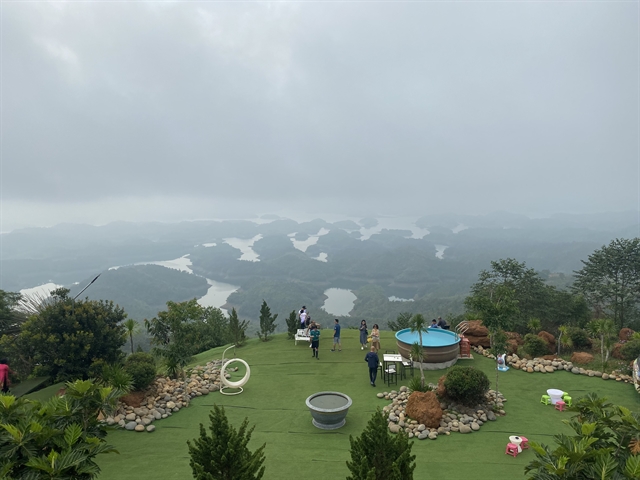Weather:
- Ha Noi 33oC
- Da Nang 28oC
- Ho Chi Minh 33oC

By Lâm Giang
In the quest for natural beauty, there's a universal appeal that transcends borders, luring both the wanderers of the world and local enthusiasts. It is in this shared aspiration that one stumbles upon the mesmerising Đắk Nông Province, its charm personified by Tà Đùng Lake.
Nestled within Đắk Som Commune of Đắk G’long District, the stunning Tà Đùng Lake is approximately 50km from the vibrant Gia Nghĩa Town and a further 170km from the lively metropolis of Buôn Mê Thuột City, forming part of Đắk Nông Province.
Covering an impressive 22,103ha, this freshwater lake's appeal lies not only in its size but also in the pristine waters that reflect the vast sky above. To further complement the spectacle, about 40 islands of varying sizes surface from the depths, dotting the body of water and providing a visual feast for the observer. Enveloping the lake is a grand spectacle of mountainous terrain, amplifying this natural beauty.
Tà Đùng Lake traces back to the construction of the Đồng Nai 3 Hydropower Plant. This human feat of engineering facilitated the creation of a colossal reservoir by damming a tributary of the Đồng Nai River. The resulting man-made lake, with an average depth of approximately 20m, is testament to the harmony of human ingenuity and the timeless beauty of nature.

There are two routes to reach Tà Đùng. One could take National Highway 14, leading towards Đắk Nông, before progressing to Gia Nghĩa Town and finally National Highway 28 via Quảng Khê District to reach the destination.
Alternatively, from HCM City you can take National Highway 20 towards Di Linh, before switching onto National Highway 28.
Upon setting sights on Tà Đùng from a distance, it seems as if an artist has captured the surreal beauty of nature and crafted a painting of immense beauty. The sight of floating islands nestled in the waters draws comparisons to a miniature version of the famed Hạ Long Bay, nestled in the Highlands.
As an ecological treasure, the area is home to a diverse range of bird species, many of which are endemic to the region. An estimated one-eighth of all bird species in Việt Nam can be found here, earning it recognition as one of 222 regions globally renowned for their endemic bird species.
To immerse ourselves in the majestic landscape, we opted for a boat ride. Renting a boat, accommodating approximately 15 guests, came at a modest price of around VNĐ1 million (equivalent to US$43).
As we journeyed across the water, local residents told us the legend of Tà Đùng Mountain. According to local folklore, B’Nam Village, once a fertile plateau, frequently experienced devastating floods during storms, making life challenging for its inhabitants. In response, village patriarch Tang Klao Ca ventured into the forest, seeking the assistance of two brother saints, Saint Dít and Saint Dri. These benevolent beings agreed to help and met with Cột Vồng, the sea god, requesting a few mountains to be placed near the village. These natural barriers would provide shelter for the villagers during the treacherous storms and floods, the tale goes.

The legend tells of two mountains, the first to arrive being named the Father Mountain, followed by the Mother Mountain. In their profound gratitude, the villagers held a ceremony to express their appreciation to the gods. Yet, their omission of the god Ba Trặc from the guest list incurred his ire. In an attempt to assuage his anger, the villagers hastily convened another feast.
Subsequently, a remarkable phenomenon took place -- the Father Mountain, now teeming with oversized sugar canes. Initially, the villagers dubbed it B’Nam Tào Dung, translating as 'the mountain of large sugar canes'. However, as time ebbed away, it was rechristened to Tà Đùng Mountain.
Following this rich exploration of folklore, we set up camp near the tranquil lake, perfectly positioned to witness the dawning of a new day in Tà Đùng. As the sun peeked over the horizon, we feasted on an array of delectable local dishes -- juicy grilled chicken served with rice prepared in a bamboo tube, Dak Glong guava, a variety of forest vegetables, and a selection of the lake's fish.

As we slept alongside the serene lake, the experience of breathing in the crisp, fresh air and gazing up at a night sky bedecked with stars was an encounter of true bliss.
Dawn at Tà Đùng brought an astonishing spectacle; the first rays of sunlight unveiled a magnificent panorama enveloped in a thick blanket of clouds. The cloudy veil took on whimsical forms, casting its charm everywhere -- from the verdant yard to the winding roads, from thriving coffee plantations to lush wildflower meadows.
The untamed allure of the lake, coupled with its distinct ecological characteristics, proved irresistible, casting a captivating spell over us. The freshness of the air seemed to dissipate any fatigue, invigorating our spirits.
Our exploration extended beyond the Tà Đùng Lake to some of the fascinating attractions nearby.
One such marvel was Chu Bluk Cave, renowned as the longest volcanic cave in Southeast Asia. An impressive network of over a hundred caves, both large and small, punctuate the landscape here, each offering its own unique appeal. This underground labyrinth further impresses with its rich, diverse ecosystem.
In addition, Diệu Thanh Waterfall, also known as Liêu Nung Waterfall, is another beautiful site. The waterfall cascades from a height of 30m down to the crystal-clear streams underneath. VNS


